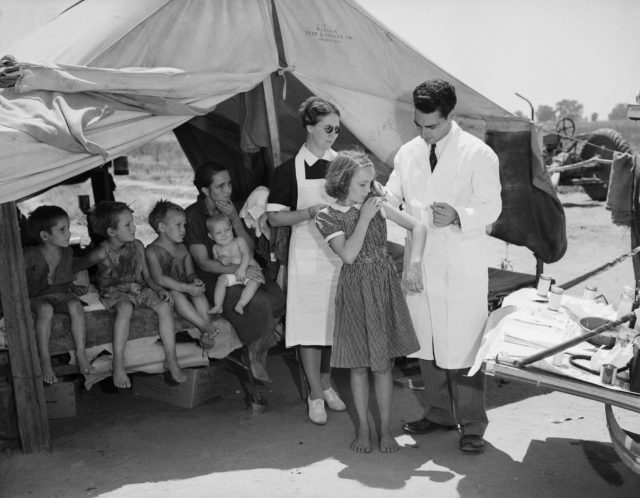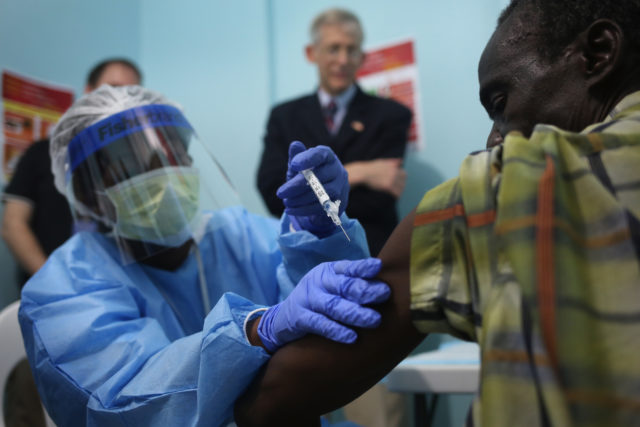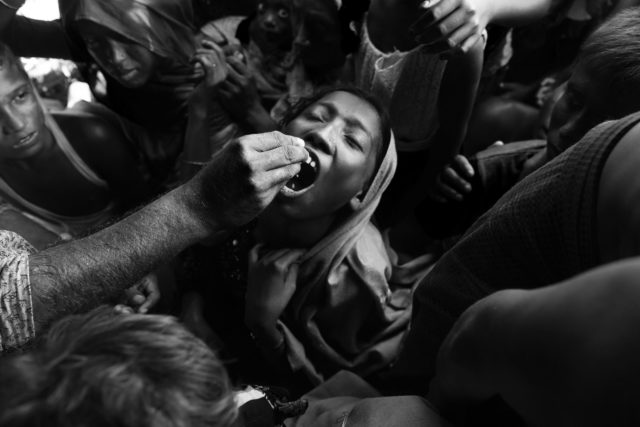In the coming months, one of history’s most ambitious vaccination campaigns will begin in earnest. Complex political, social and cultural factors will shape public reaction to a COVID-19 vaccine, and communication surrounding the vaccine’s arrival will be as critical as its underlying efficacy. Before entering the fray, reflecting on some powerful vaccination images can help us frame the conversation.
Themes that emerge from vaccination photographs mirror the impact and ambiguity of the practice itself: the triumph of medical science, doctor-patient power dynamics, and the implicit trust requisite in the offer of a vaccine (or lack of it, referenced even in Norman Rockwell’s Before the Shot, as the young patient examines the doctor’s credentials while the injection is prepared).
Photographs of the act of vaccination expose these ideas and relationships a single frame. Iconic pictures come to mind: Jonas Salk on the cover of Time magazine, Pakistani children receiving drops from humanitarian workers under the protective eye of armed guards.
On initial gaze, a 1939 photograph from an uncredited photographer celebrates the promise of early 20th Century medicine: a physician in an impossibly clean white coat administers smallpox and typhoid vaccinations to a young girl. The girl seems not only trusting, but eager to participate as she rolls up her sleeve. She is nicely groomed and well dressed — far better than the young woman and children who look on. If these are the patient’s siblings, they are not nearly as presentable — suggesting that the girl wore her Sunday best to receive such a precious gift, or else that her look was staged in order to present the best face of public health. Nonetheless, her bare feet give her away.

The doctor and nurse here have constructed a makeshift clinic in the back of their vehicle, distributing vaccines at this squatter camp in Visalia, California on behalf of (or, perhaps at the decree of) the state public health department. The doctor, in spotless shoes, drives the action. The sponsoring institution reads as authoritarian but benevolent, mitigating contagion in a group of vulnerable children presumably displaced from the latter phases of a dust-bowl Midwest.
The temptation here is to consider this a simpler, more paternalistic time, when physicians and the government were equally trustworthy, and medicine and public health pointed to a better American life. If there is skepticism or fear here, it lies below the surface. Remember, though, that a few years earlier, initial results of the Tuskeegee syphilis study had been published, and physicians were asked to withhold treatment from study subjects. The California eugenics movement flourished in the 1930s, perhaps at odds with the public health populism suggested in the photo.
John Moore’s 2015 photo of an Ebola vaccine trial in Monrovia, Liberia offers the same promise and potential as the earlier photograph, albeit with undertones of research done on a vulnerable population at the hands of a deadly epidemic. The nurse brandishing the syringe is likely a local health worker, and her patient seems ambivalent, if not eager, to receive the injection. In the unfocused background at the edge of the frame stands Dr. Clifford Lane, of the NIH’s National Institute for Allergy and Infectious disease, arms crossed, safely distanced. There is both optimism and uncertainty here, presumably voluntary participation coupled with some degree of implied skepticism in the midst of a terrifying outbreak.

Sometimes the suspicion is justified. In the months leading up to the killing of Osama bin Laden in May 2011, the CIA sent a hepatitis B vaccination team into the Bin Laden compound, presumably to collect information and DNA samples to help confirm the presence of Bin Laden family members. Reports of the American backed ploy stoked anger among villagers throughout Pakistan, who accused vaccination teams of being tools of the American government.
In 2017, Rohingya refugees in a Bangladeshi refugee camp received oral cholera vaccine from volunteers as part of a UN vaccination drive. Indranil Mukherjee’s photograph of a young refugee extending her neck to receive the drops skews religious, a communion from a faceless distributor hovering over a throng of potential recipients. They may be clamoring for their own chance at the medication, or else just curious or skeptical. This image too is somewhat ambivalent, suggesting the promise of better health in the face of a mysterious potion, offered by a faceless hand, with some degree of assent but maybe not full understanding of what’s being offered.

Health communication researchers recently analyzed images of vaccines in news stories, coding them as grossly positive (“happy patient”), negative (“screaming child”) or neutral. The researchers identified the images to be included in their study by searching for value-laden topics like “autism and vaccine” and “measles and Disneyland.” The study implies a concern that negative imagery might foster vaccine hesitancy, and suggests that editors consider that consequence when selecting images to accompany news stories. The authors argue that the media ought to be cognizant of the “negative impact on public health initiatives regarding vaccination.”
Is an image of a screaming child “negative?” Injections hurt and children cry. But some observers could find an overwhelming positivity in the image of an unhappy child receiving a vaccine – perhaps a measles inoculation following a disaster, or a child receiving an Ebola vaccine, or a second-grader returning to school in a post-COVID world.
To be sure, each of these images may be interpreted as powerfully positive, or negative, or both. Mostly, they are complicated and sometimes indecisive. The stories these photographs tell inform the way we offer vaccines now, and how the media and physicians alike confront challenges to vaccine effectiveness or safety, or the motivations for delivering them. Collectively, these moments impact ought to enlighten conversations that we have with individual patients, as well as those that ultimately shape critically important public policy.
____
Christopher Tedeschi is associate professor of emergency medicine at Vagelos College of Physicians and Surgeons at Columbia University.